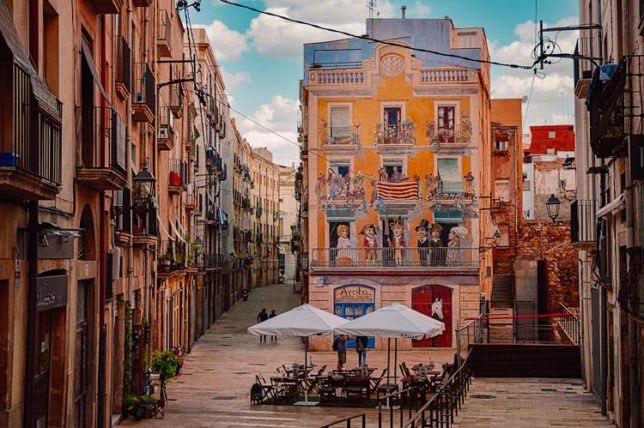Many landmarks in Greece are some of the most famous in the world, and it’s no surprise why.
Greece is one of the most beautiful countries in Europe, with a very diverse landscape.
Not only is it filled with history and culture, it also has myriad natural landmarks including islands, mountains, forests, beaches and more.
The Acropolis in Athens is one of the most famous landmarks in Greece.
And built 2,500 years ago, the Parthenon towers over an ancient city that has shaped Western civilization.
If antiquity isn’t what draws you to Greece then surely its beaches will! There are hundreds upon hundreds of miles worth exploring across this stunning Mediterranean coastline with crystal clear waters and abundant sunshine.
For those looking for something more active there are plenty of opportunities to hike, or do watersports, snorkeling etc.
You Might Like: 49 of the Most Famous Landmarks in Spain
FAMOUS LANDMARKS IN GREECE
This post is about the important landmarks that make Greece unique and unforgettable. Whether you’re interested in seeing the famous Acropolis or looking to learn about ancient history in Olympia, this article has you covered with all you need to know about the Mediterranean paradise!
Greek Landmarks in Athens
1. ACROPOLIS, ATHENS
The Acropolis, an ancient citadel in Athens, is undoubtedly the most famous Greek landmark, and is one of the most important archeological sites in Europe.
The word ‘Acropolis’ means ‘high city’, which is exactly where this landmark is located. The Acropolis sits on top of a steep hill with beautiful views over Athens.
Built in the fifth century BC, the Acropolis is not only steeped in history and tradition, but is also HUGE. It covers an area of 7.4 acres!
The site is home to some of the best preserved ancient temples of Greece, including the Parthenon and the Erechtheion.
With a wide array of relics and monuments dating back to millennia ago, you can easily spend a half day doing a guided tour and exploring this important landmark in Greece.
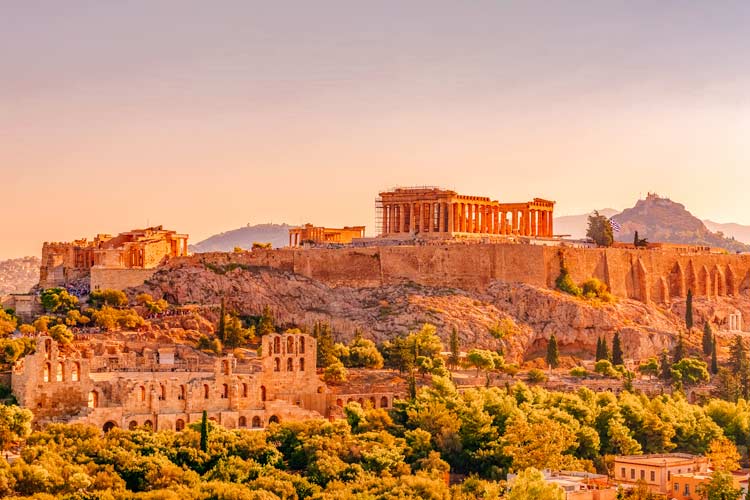
2. PARTHENON, ATHENS
Built more than 2500 years ago, the Parthenon is one of Athens’ most iconic landmarks. It is a temple located on top of the Acropolis.
The word ‘Parthenon’ means “the virgin’s chamber”, which refers to its status as a temple for the Greek Goddess Athena.
The temple was built with a large number of stones that fit together so perfectly that it was impossible to fit a piece of paper between them. The walls carry carvings depicting scenes from Athenian history.
There were many large statues on the temple, including one of Athena herself standing tall at 13 meters.
Unfortunately, the Parthenon was destroyed in 1687 when an Ottoman shell landed on it during a battle for Athens’ control.
Today, there is an ongoing restoration process to help preserve this historical landmark and make sure it can be cherished and revered by future generations.
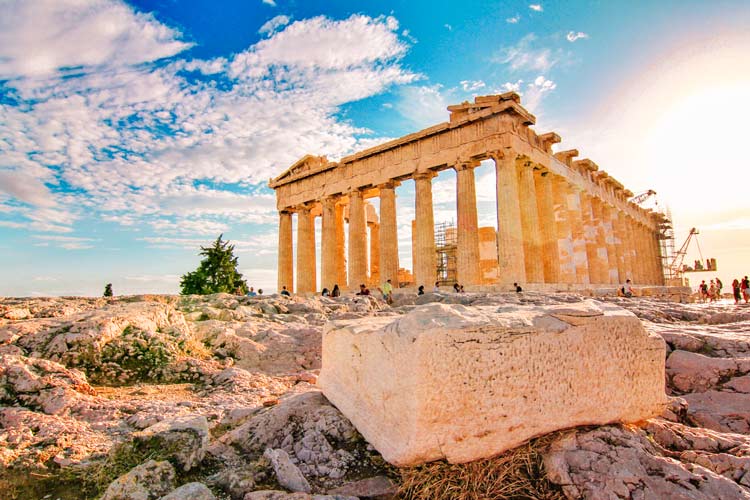
3. TEMPLE OF OLYMPIAN ZEUS, ATHENS
The Temple of Olympian Zeus, also called the Olympieion or Columns of the Olympian Zeus, was built in Athens to honor the Greek God, Zeus.
It is one of the most impressive structures from ancient Greece and it’s not hard to see why that is.
The temple construction was started in the sixth century BC but it wasn’t completed until the second century AD during Roman rule. There were a total of 104 white marble columns, each 55 feet tall. The structure was built to be the largest temple in Greece.
However, the temple was pillaged and destroyed over the years, and then it suffered a major earthquake in 1852 that caused further damage.
Today, only 15 of the temple’s original pillars remain standing.
Nonetheless, the Temple of Olympian Zeus is one of many landmarks in Athens that has survived since the time of ancient Greece. It carries huge historical significance and remains an integral and indelible part of the country.
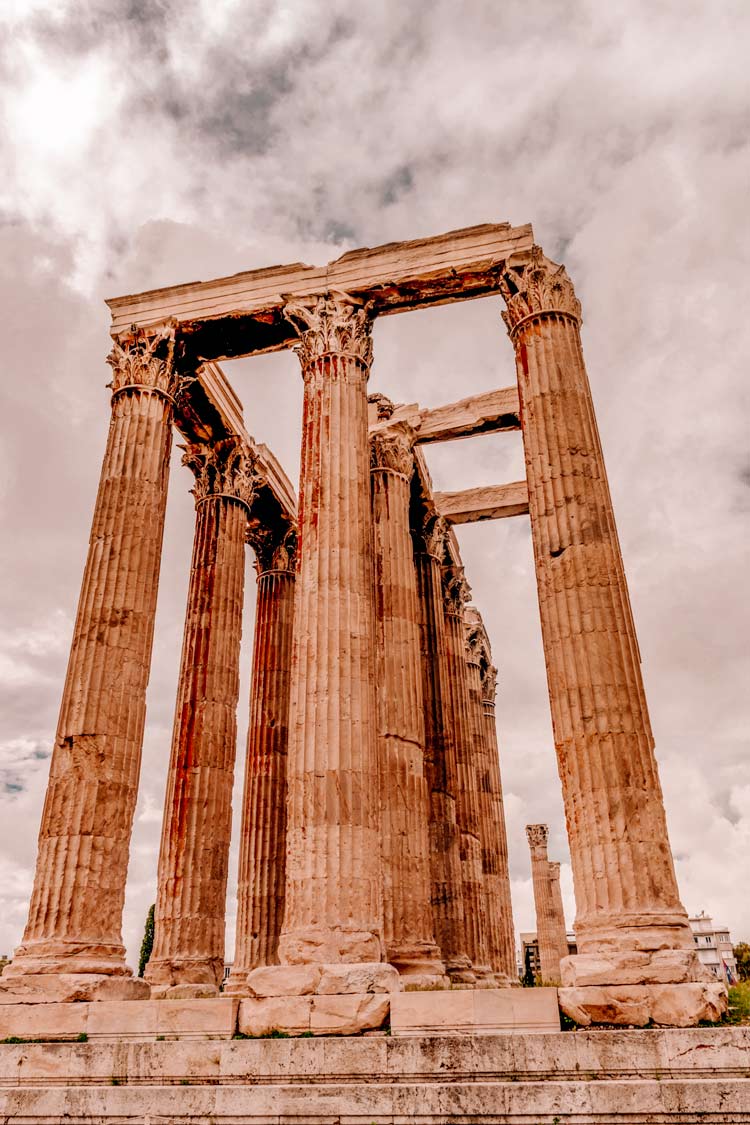
4. ACADEMY, ATHENS
The Academy of Athens serves as the highest educational institution in Greece, and is a very important landmark to the country.
Founded in 1926, it is renowned to be the national academy of Greece. It currently runs under their Ministry of Education.
The Academy of Athens presently maintains 14 research centers, seven specialized research units, and a library.
By the entrance, visitors are greeted by two large sculptures of Plato and Socrates.
The main building of the Academy is its most significant part, and is a fine example of neoclassical Greek architecture. The building is modelled on the Parthenon and was designed by the Danish architect, Theophil Freiherr von Hansen.
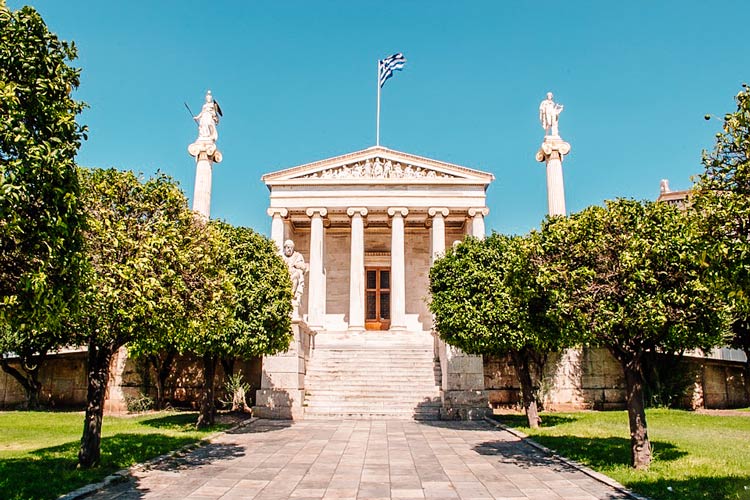
5. ANCIENT AGORA, ATHENS
An ‘Agora’ is a term for an open space in ancient Greece that was used as a market square and a place to socialize.
The Ancient Agora of Athens is the best-preserved example of the Greek Agoras.
Located on the foot of the Acropolis, this ancient Greek landmark served (and still serves) as a place for public meetings and events.
The Agora is bound on the south by the Areopagus, and on the west by the Market Hill.
It also houses a museum, which contains several artefacts from the Athenian civilization, as well as remnants of Greece’s Byzantine and Turkish history.
The Agora immortalizes the Western Greek civilization, and in more ways than one, is an iconic landmark in Greece.
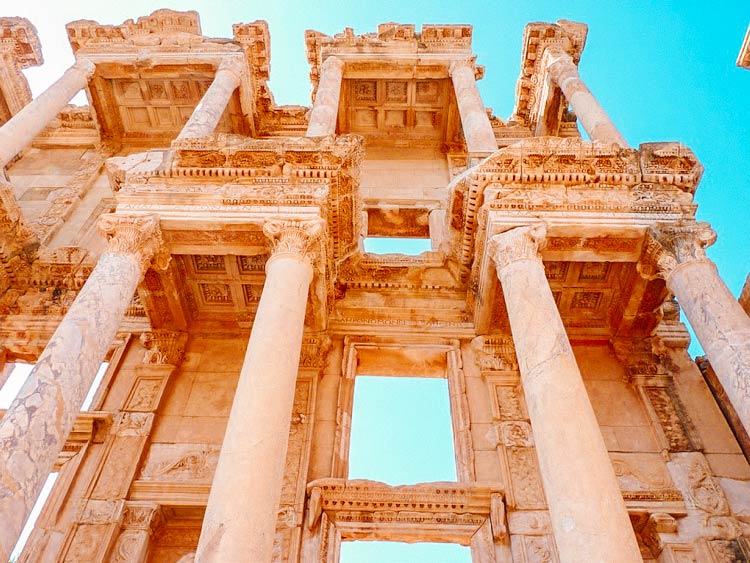
6. SYNTAGMA SQUARE, ATHENS
One of the most famous Greek landmarks in all of Athens is Syntagma Square. Also known as Constitution Square, it’s a large public space and the central point of Athens.
The square is surrounded by major public buildings, including the Greek Parliament building located in the Royal Palace.
It has been home to many major events, from political demonstrations to festive celebrations. This puts the square at the center of the Greek political, economic and cultural landscape.
In fact, the famous military uprising of 1843 took place at the Syntagma Square, when the Athenian citizens rebelled against the autocratic rule of Otto, the first king of Greece. The uprising led to the establishment of Greece as a constitutional monarchy.
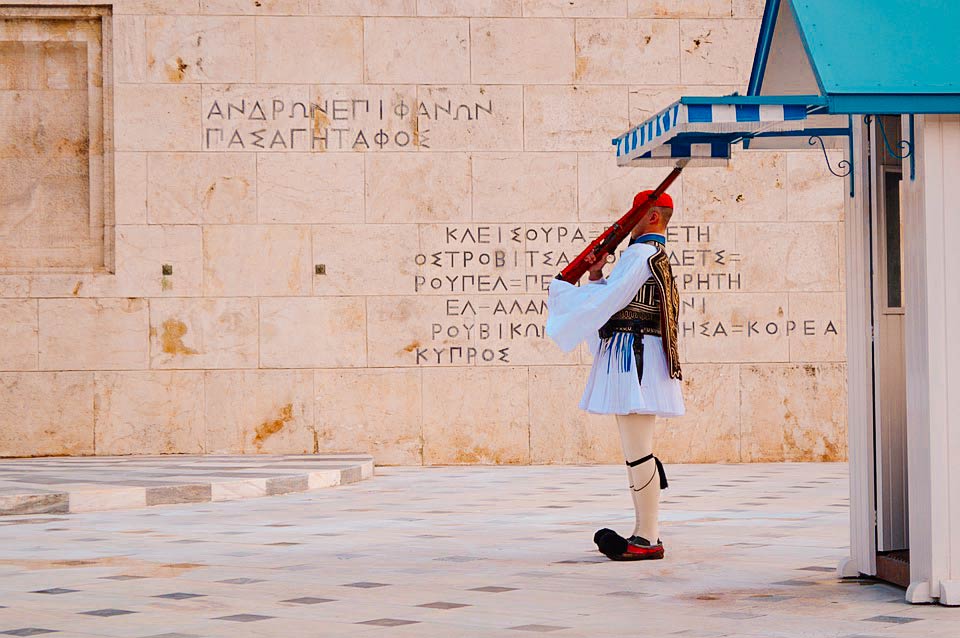
7. PLAKA, ATHENS
Plaka is a historical neighborhood in Athens, nestled in the shadow of the Acropolis.
It’s one of the oldest areas of the city, and you can find a quaint, laidback vibe here.
Filled with sidewalk cafes, galleries and restaurants, this is a great area to absorb the culture, while admiring the off-white building facades.
Plaka is also the perfect destination for souvenir-shopping and to partake in some of the local cuisine at one of the many family-run tavernas.
In the evening, you can take a walk by the towering Acropolis and enjoy spectacular views of Athens at night.
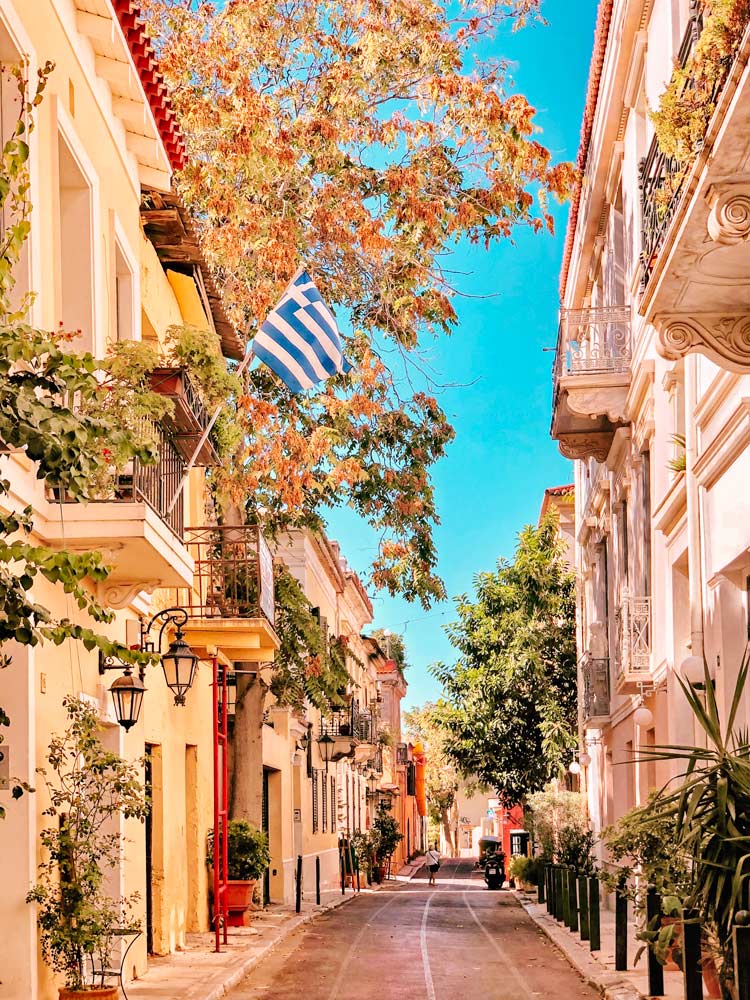
8. MOUNT LYCABETTUS, ATHENS
This is a great natural Greek landmark that provides visitors with an incredible view of the city.
The summit of Mount Lycabettus is the highest point in central Athens. Visitors can climb up to the summit of the limestone hill by foot, or take the funicular from the Kolonaki terminus, located on Aristippou street.
Once at the top, there are several cafes and bars where you can stop, catch a breath, and admire 360-degree views of Athens.
Mount Lycabettus is actually one of the oldest mountains in Greece. It features in many Greek legends and folklore.
In fact, legend has it that the Greek Goddess Athena, accidentally dropped a huge rock of limestone while on her way to build the Acropolis, which ended up becoming Mount Lycabettus.

9. PANATHENAIC STADIUM, ATHENS
The Panathenaic Stadium, also called Kallimarmaro, is a stadium located in Athens.
It is known as the first Olympic Stadium for its use during opening and closing ceremonies of the 1896 Olympics.
However, the stadium was actually built in the 4th century BC to be used for Panathenaic Games, a religious and athletic festival in Ancient Greece.
One curious feature of the Panathenaic Stadium is that it’s the world’s only stadium built entirely of marble.
It has been restored several times throughout history and it is still used for sporting events today. The stadium can currently hold around 45,000 people.
Fun fact: The medals for the Tokyo Olympics 2021 feature the Panathenaic Stadium and the Nike, the Greek goddess of victory, standing in front of it.
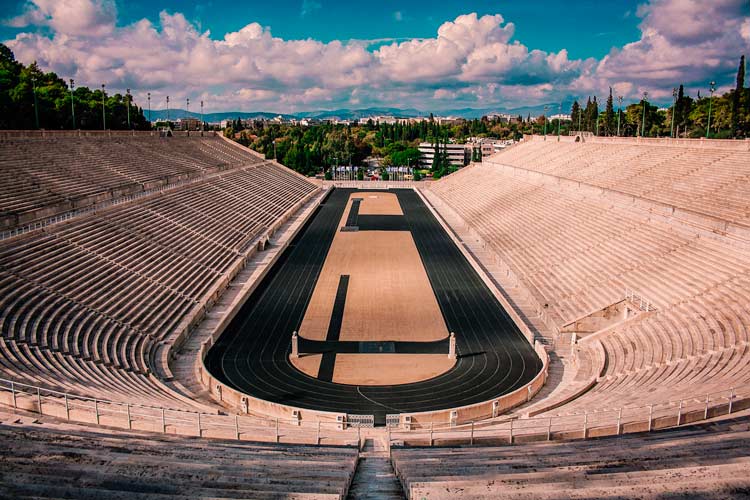
10. OLD ROYAL PALACE, ATHENS
This is the first royal palace of modern Greece. With an imposing and brilliant neoclassical facade, the palace is one of the most important and conspicuous sites of the Syntagma Square.
With a rich history, the palace played an important role during Greece’s transition from a monarchy to a republic.
The Royal palace was designed in 1843 by the German architect Friedrich von Gärtner for King Otto of Greece.
King Otto stayed in power for 30 years, but in 1863 he was replaced by Prince William of Denmark, elected by the Greek National Assembly as King of the Hellenes.
Over the next few decades, the palace suffered two major fires. Due to the imminent restoration work, the royal family started moving out.
After the abolishment of Greek monarchy in 1924, the palace went on to serve a slew of different purposes over the years: refuge shelter, makeshift hospital, and a museum.
The building has been serving (even currently) as the site for the Hellenic Parliament since 1935. It is open to visitors for guided tours.
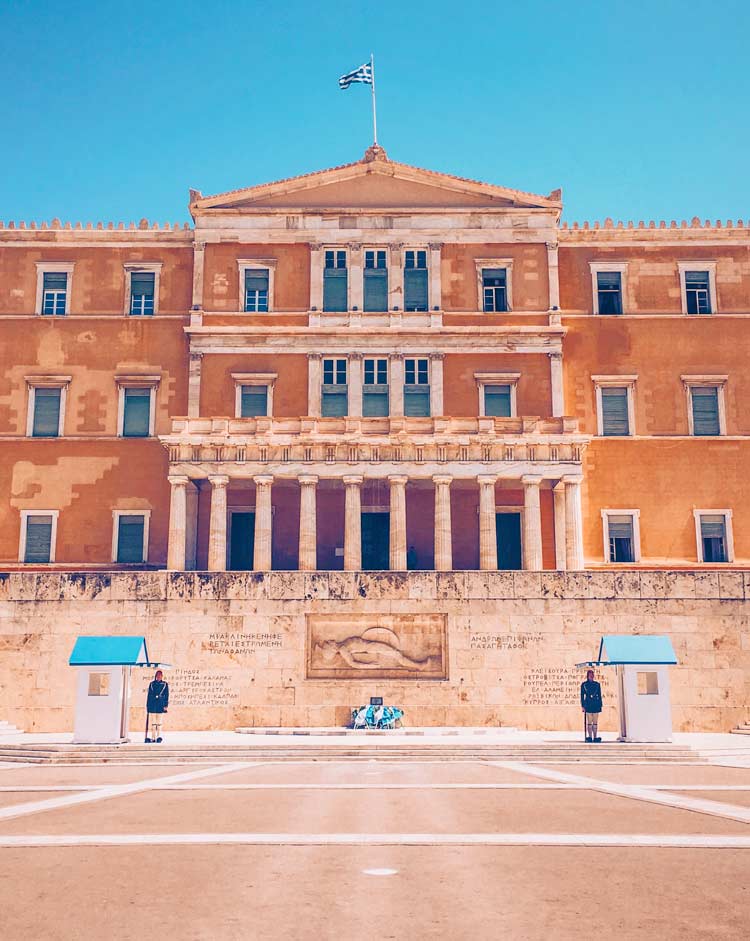
Historical Landmarks in Greece
11. MINOAN PALACE OF KNOSSOS, CRETE
The Minoan Palace was built in Knossos, Crete in 1900 BC. One of the largest archeological sites from the Greek Bronze Age, the palace complex served as a political and administrative center for the Minoans, who were among the first ancient Greek civilizations.
Several artefacts from the Minoan era have been discovered in Knossos, like the famous Bull’s Head Rhyton, a ceremonial drinking vessel that is thought to be representative of Minoan bull sacrifices.
Today, you can visit this amazing site which is widely regarded as one of the most important landmarks in Greece. The complex is known for its monumental architecture, but what makes the Minoan Palace especially intriguing is its significance in Greek mythology.
The most famous legend associated with the palace is the myth of the ‘Minotaur’. The half-man, half-bull creature was said to live in a maze-like labyrinth constructed within the palace walls by King Minos.
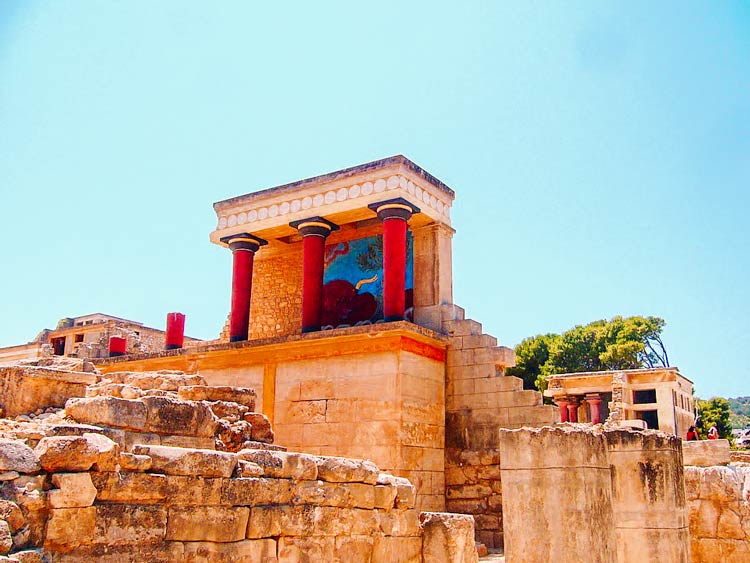
12. ANCIENT CORINTH, PELOPONNESE PENINSULA
Corinth was a city-state in ancient Greece, and the birthplace of both democratic government and philosophy. What makes this an important Greek landmark is that it was one of the largest and most powerful cities during ancient times.
The city was built on a strategic location which allowed it to control trade between Asia Minor, mainland Greece, Crete and Italy.
In 146 BC, the Romans destroyed Corinth and built a new city in its place in 44 BC, which became the provincial capital of Greece.
Corinth was also the home of one of the twelve apostles, St. Paul, and is mentioned several times in the New Testament.
It’s important to remember that the Corinth of today isn’t exactly what was left behind by its ancient inhabitants. The ruins of the ancient city are located close to the current city of Corinth, as we know it.
Ancient Corinth contains some unique landmarks, including temples dedicated to Apollo and Aphrodite, as well as an amphitheater capable of seating thousands of people! The city also has an acropolis called Acrocorinthis which you can visit.
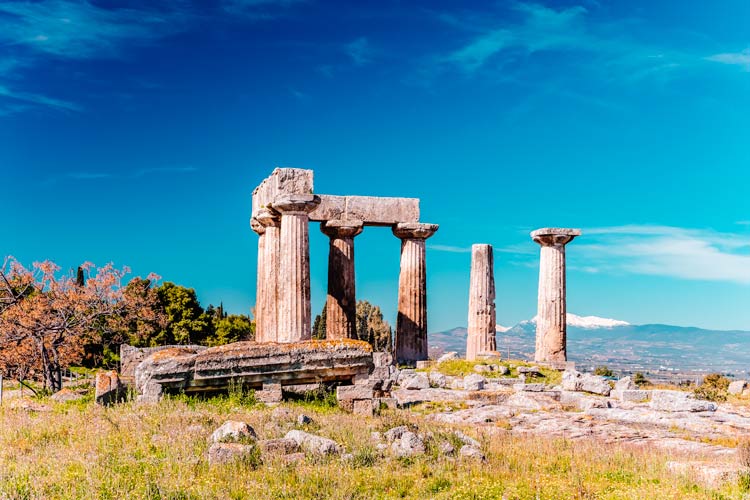
13. SANCTUARY OF DELPHI, PHOKIS
The Sanctuary of Delphi is a famous ancient site in Greece, located on the slopes of Mount Parnassos, about 80 km from Athens.
In ancient times it was considered to be the center of the world and was thought to have been built by Apollo himself as his sacred home. People came from all over Ancient Greece to seek the advice of the oracle priestess, called Pythia.
Among the sanctuary’s many attractions are the Temple of Apollo, which was built in the Doric order, and the Tholos of Delphi – a circular structure that is believed to have been where the Pythia priestesses spoke prophecies.
Today, the sanctuary is a historical landmark UNESCO World Heritage Site.
Visitors can see ruins and artefacts from the period, as well as visit the Delphi Archeological Museum to learn more about the fascinating history of the sanctuary.
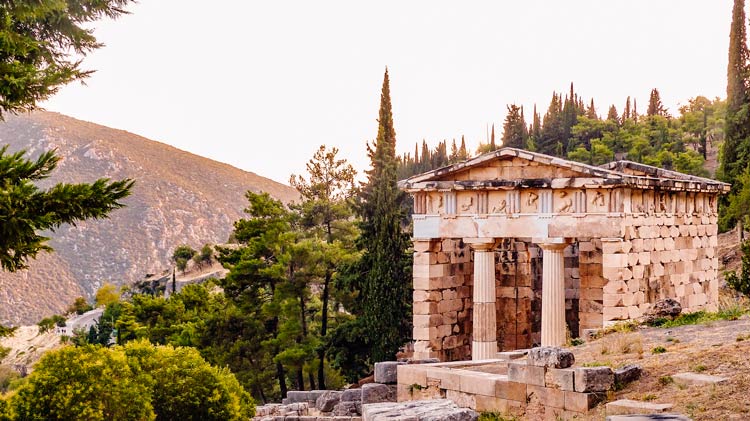
14. TEMPLE OF POSEIDON, SOUNION PENINSULA
Temple of Poseidon sits atop Cape Sounion Peninsula in southern Greece. It was constructed during 444-440 BC and is now one of the most famous ancient Greek temples. At an elevation of 60 meters, it offers panoramic views of the Aegean Sea.
A UNESCO World Heritage Site and popular day trip from Athens, this ancient Doric temple was built in the 15th century BC in honor of Poseidon, god of the sea.
The temple’s design is similar to that of many other Greek temples – it has a rectangular platform and several columns, with an inner sanctum and a front portico.
Poseidon Temple’s history, along with its dramatic setting, make it an important and famous landmark in Greece.
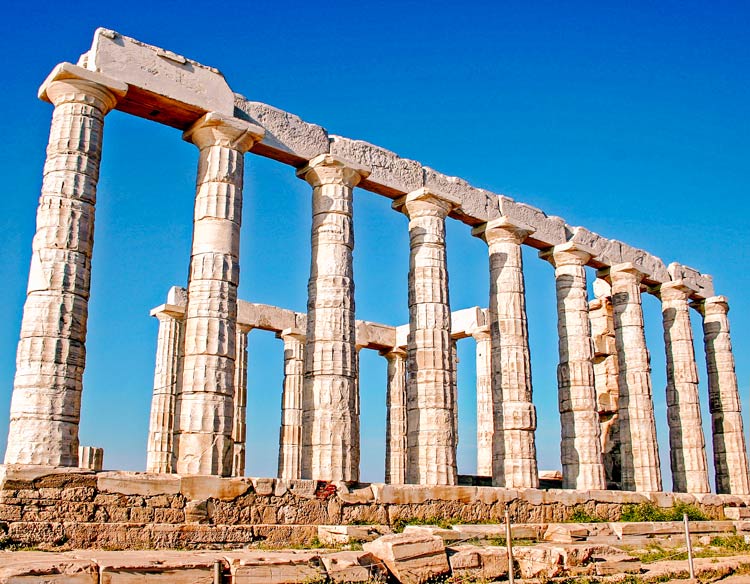
15. ANCIENT OLYMPIA, PELOPONNESE PENINSULA
Ancient Olympia is an archeological site that marks the birthplace of the Olympic Games. Built in the 8th century BC, it witnessed athletes competing in the presence of scores of spectators, to honor their gods.
Olympia is one of those places where you can truly see what life was like thousands of years ago. The stadium used for the games is still largely intact.
Parts of it are open to tourists, so you can get a sense of what competing in the Olympics would have felt like. The site also has statues and various other artefacts from ancient Greece that give an insight into daily life at this point in time. Many of these artefacts are preserved in the Ancient Olympia Museum.
Olympia’s notable ruins also include temples devoted to Zeus and Hera, as well as the Pelopion. The latter was where athletes would leave sacrifices after completing their events, to honor Pelops, a local mythological hero.
Today Olympia is one of the most famous landmarks in Greece – not only for its historical importance but also for its natural beauty. Surrounded by lush forests and traditional villages, it’s one of the most picturesque places to visit in the country.
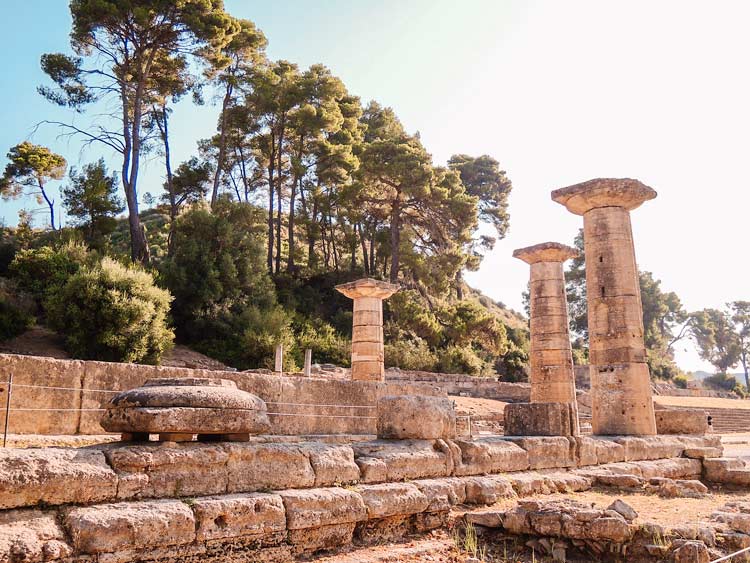
16. APOLLO TEMPLE – PORTARA, NAXOS
Although the island of Naxos is filled with photogenic Greek landmarks, its main claim to fame is the Temple of Apollo – Portara.
This is an unfinished temple located on the southern tip of the island, on the islet of Palatia. It is dedicated to the Olympian God, Apollo.
Lygdami, a tyrant in Naxos, undertook the construction of the temple in 530 BC, with an aim to make it the most glorious and magnificent building in Greece. He was, however, overthrown in 503 BC, leading to the abandonment of the site.
The Portara – literally meaning ‘the gate’ – consists of four marble blocks, each weighing 20 tonnes.
Even though it was never completed, the Temple of Apollo – Portara is one of the best preserved ancient temples in Greece. The remaining parts of its foundation symbolize a ‘gateway’ between land and sea, and hold great importance in Greek mythology.
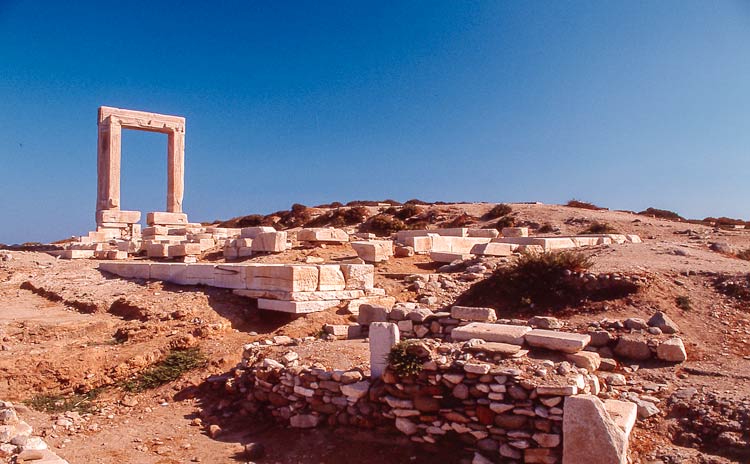
17. AKROTIRI, SANTORINI
Akrotiri is an archaeological site and a famous Greek landmark located in Santorini.
A flourishing city during the Minoan Bronze Age, Akrotiri was buried in an eruption of the Santorini volcano.
When excavated in 1967, the settlement was covered in a heap of volcanic ash, which ended up preventing most of its parts from getting damaged.
Today it is one of Greece’s most important archaeological sites and a major destination for tourists visiting Santorini.
Thousands visit every year to see its preserved ruins that are so well-maintained they look like they could have been built yesterday. In fact, the site is said to have inspired Plato’s story of Atlantis back in 360 BC!
Among the ruins of Akrotiri, the prehistoric frescoes and wall paintings stand out the most. The Cycladic frescoes and wall paintings are some of the oldest in the world, dating back to 1600 BC.
The vivid depictions are a rare glimpse into bygone times and give visitors an idea of what life was like in that era.
Akrotiri is very close to one of the prettiest beaches on the Aegean Sea, the Red Beach. You can catch a bus from Fira, the central bus station on the island, that takes you directly to the Red Beach parking. From here, Akrotiri is a mere 250 m walk away.
Protip: Make sure you get a guided tour! There is very little visitor information at the site, so having a guide is important to understand the relevance of Akrotiri in prehistory.
You can check out this really cool (and economical) tour from Get You Guide. It includes the entry ticket to Akrotiri, and a licensed archeologist as a guide so you can get an in-depth understanding of this prehistoric civilization of Santorini.
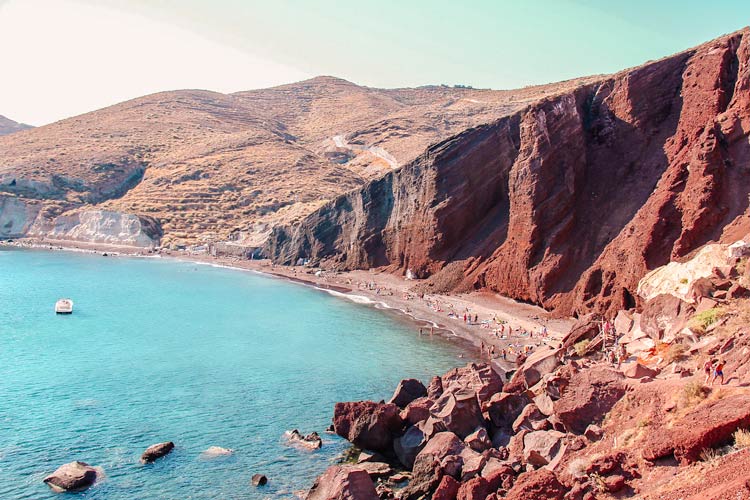
18. MONUMENT OF ALEXANDER THE GREAT, THESSALONIKI
It’s not surprising that this monument is one of the most spectacular ones in Greece. It was built to commemorate Alexander The Great, who hailed from Macedonia bordering northern Greece, and it stands an impressive 20 feet tall!
The statue depicts Alexander wielding a sword atop his galloping horse, Bucephalus, and is made of bronze.
Bucephalus was known as one of the most intelligent and brave horses in history, so it’s fitting he was immortalized next to his master.
An important part of Thessaloniki’s cityscape, the site of the monument of Alexander offers incredible views of Thermaikos Bay and the White Tower.
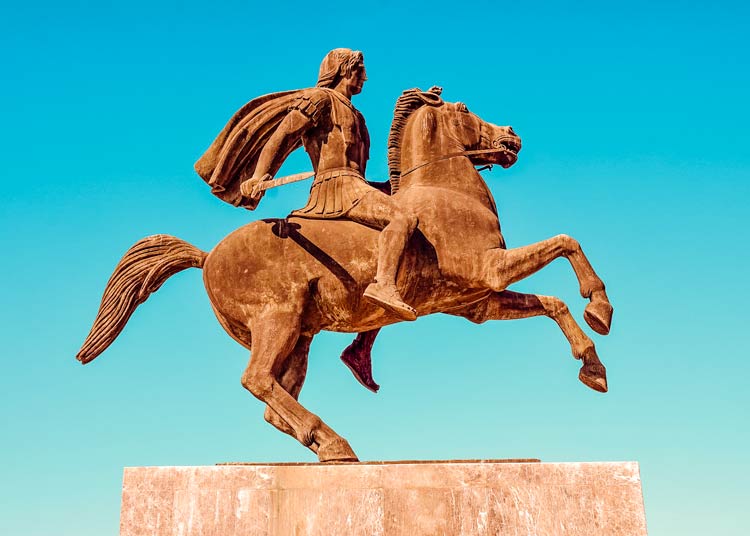
19. ARCHEOLOGICAL SITE OF MYSTRAS, LACONIA
A UNESCO World Heritage Site and a famous landmark in Greece, the Archaeological Site of Mystras (Mistras) is a prime example of Byzantine architecture.
Mystras is a fortified town located in the Peloponnese region, near ancient Sparta, and it was the last stronghold of the Byzantine empire. It includes several churches, and museums containing artefacts that date between the 13th to 16th century.
The site is divided into three sections: the Upper, Middle and Lower Cities. A combined ticket allows you to start at the Upper City and make your way down.
One of the best preserved sites of Greece, Mystras is an important window into Greece’s medieval past. It’s a must-visit for all history lovers!
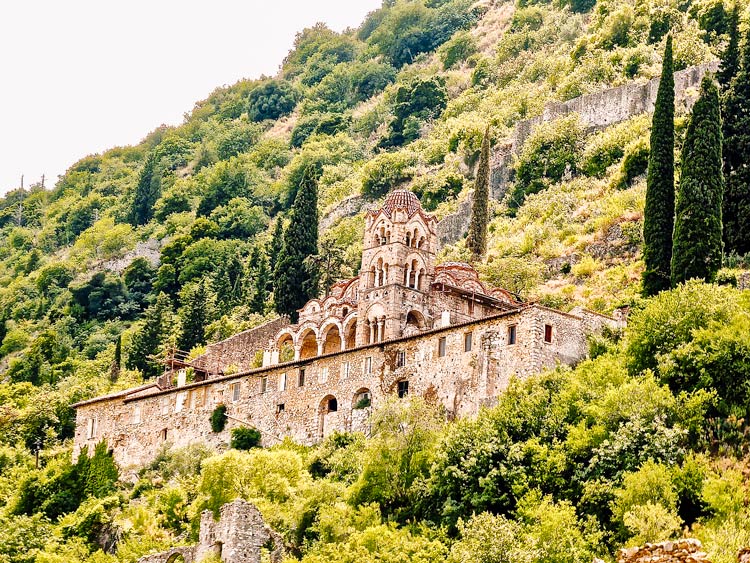
20. MONASTERIES OF METEORA, KALABAKA
Meteora is a cluster of natural sandstone rock pillars. Sitting on top of these pillars are the six monasteries of Meteora.
Built hundreds of years ago, these monasteries are some of the best-preserved in Greece, despite their age. They are also extremely well-known and famous for their unique architecture.
Each monastery is built at a different altitude to take advantage of the stunning views each one offers.
Originally there were 24 monasteries, six of which are still functioning. The six monasteries of Meteora are:
- The Holy Monastery of Great Meteoron
- The Holy Monastery of Varlaam
- The Holy Monastery of Rousanou
- The Holy Trinity Monastery
- The Monastery of Agiou Stefanos (St. Stephen)
- Agios Nikolaos Anapafsas
Of these, the monasteries of Rausanou and St. Stephen are managed by nuns, while the others are inhabited by monks.
Meteora has been inscribed on UNESCO’s list of World Heritage Sites for both its natural beauty and historical value.
The monasteries of Meteoron (including the six above and the ruins of the other ones) offer great opportunities for hiking and surreal views of Kalabaka.
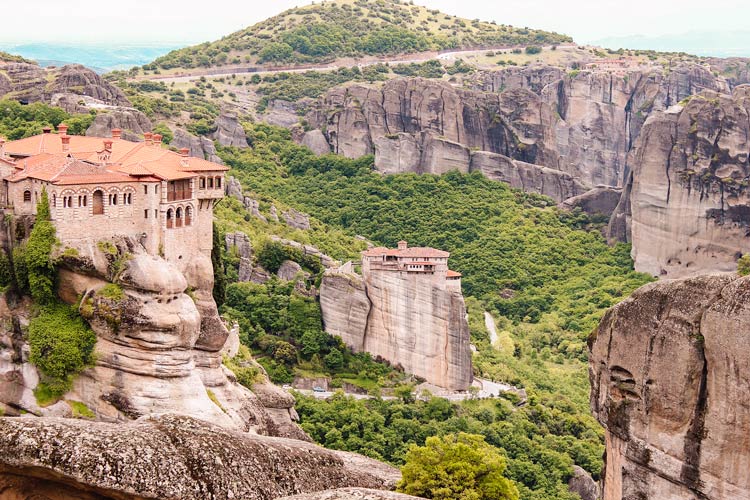
21. LINDOS ACROPOLIS, RHODES
Perched above the current modern village of Lindos is the legendary Acropolis.
One of the most notable ancient monuments of Greece, the Lindos Acropolis is a natural citadel that was fortified by the Greeks, Romans, Byzantine Empire, the Knights of St. John, and later by the Ottomans. This was to protect the area from pirates.
While it is thought to have been built in the 4th century B.C., some believe it may date back to as early as the 12th century B.C.
Only some ruins remain today, including columns from its ancient Temple of Athena, and the Doric Stoa, a colonnade that once served as an ancient shopping complex.
Lindos Acropolis is an important Greek landmark that gives us a peek into the country’s rich history.
The clifftop vantage point of Lindos Acropolis offers stunning views of the surrounding coastline and harbors. It is accessible via a set of stone stairs that lead down to the village.
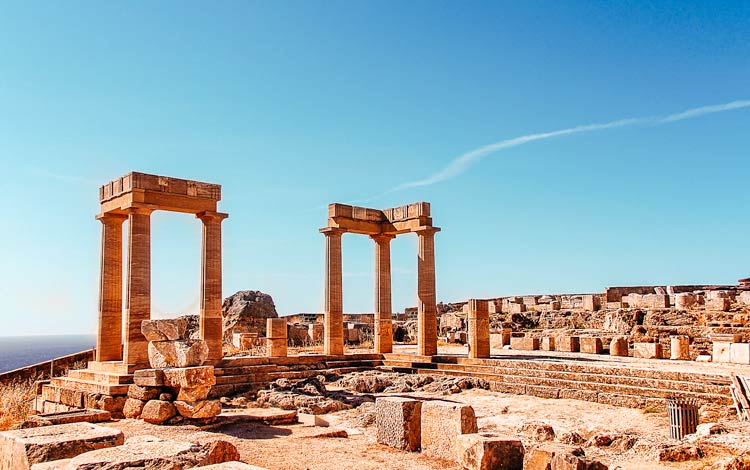
22. PALACE OF THE GRAND MASTER OF THE KNIGHTS, RHODES
Also known as Kastello, this medieval castle sits on a small hill overlooking the city of Rhodes, Greece.
It was originally built as a citadel in the 7th century during the Byzantine reign.
Later, it was converted into a castle which served as both, home to the Grand Master, and headquarters of the Knights Hospitaller (a catholic military order in the middle ages).
The Palace of the Grand Master of the Knights is famous for being one of the last remaining outposts that defended Europe from the Ottoman invasion.
Today, the palace houses some of the finest medieval art in Europe including noteworthy mosaics spanning various periods of history. There are also paintings, and alabaster sculptures made with impressive detail.
What makes the Grand Palace of Rhodes such a popular landmark is that it’s one of the only few examples of Gothic architecture in Greece.
23. ANCIENT THEATRE, EPIDAURUS
The Ancient Theatre in Epidaurus was built during the 4th century BC and it’s one of the few remaining theatres from that era. The design is based on a perfect semicircle, making up around 16 rows of seats.
The theatre could hold over 13 thousand people at its peak! In comparison to modern music concerts today, this might not sound like a lot, but for its time this was an incredible feat.
The reason for its fantastic acoustics was the semicircular seating arrangement. Additionally, the limestone steps filtered out low-frequency background noise while amplifying the sound coming from the stage. This made it possible for thousands of spectators in the audience to hear so much as a pin drop on stage.
Due to its excellent acoustics, symmetry and design, the theatre is still in use to host plays and concerts – especially during the annual Epidaurus Festival in June.
Epidaurus Theatre is one of the most important landmarks in Greece because of its unique build and what it represents – a perfect example of ancient Greek architecture that still stands strong to this day.
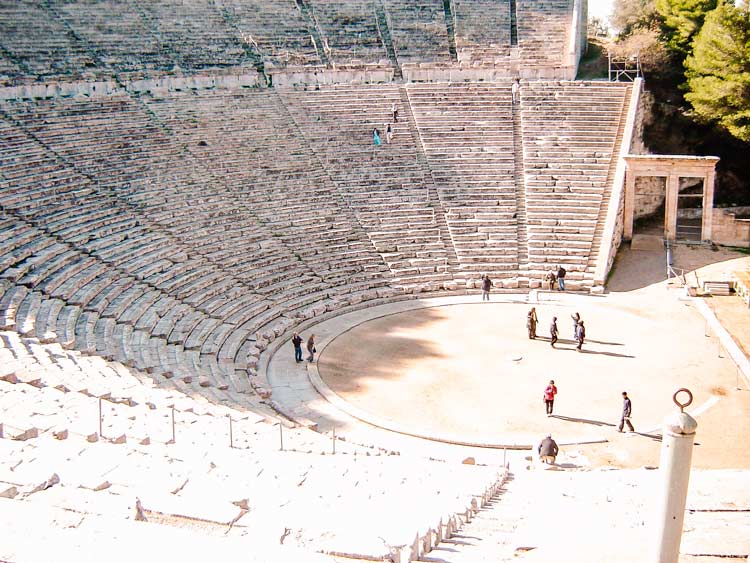
24. BOURTZI CASTLE, NAFPLIO
One of the most famous and beautiful landmarks in Greece, Bourtzi is a water castle located in the middle of Nafplio Bay, a coastal city in the Peloponnese.
It was built in 1371 as a Venetian fortress, but was later used by the Ottomans during their occupation of Greece.
At present, the castle serves as an open-air venue for cultural events and performances such as concerts and plays.
While you can take a boat from the harbor to visit the Bourtzi castle up close, it is most known for its postcard worthy setting in the middle of the water.
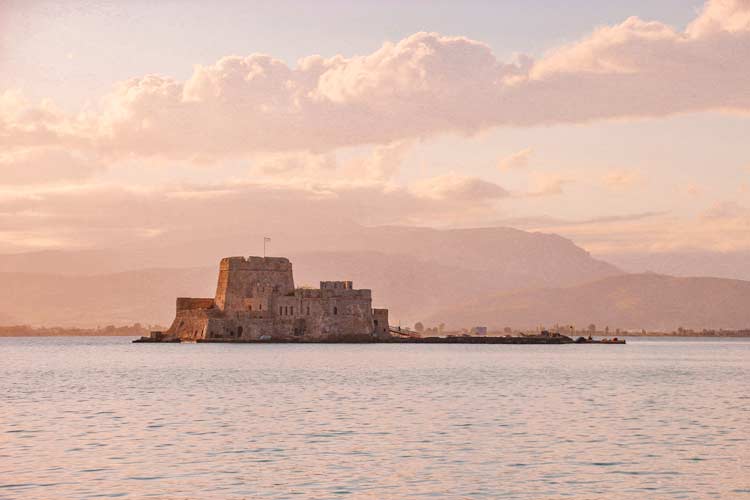
25. ARCHEOLOGICAL SITE OF PHILIPPI, KRINIDES
This archeological site is located over the border in the Macedonia region of Greece, and has been one of the bedrocks of Christian faith for centuries.
The ancient city of Philippi was first founded by Philip II of Macedon in 360 BC as a city-state and one of his final capitals before he died (the other being Aegae).
The town holds an extensive history dating back thousands of years, with archaeological ruins scattered throughout.
The reason why Philippi is so important to Christianity is because of its association with the Apostle St Paul, who was converted here after he fell off his horse, while on the road from Troas to Philippi.
The archaeological ruins of Philippi span across various kingdoms and empires, from the early Romans to the Ottomans, making the ancient city a goldmine for understanding Greece’s history.
Philippi was included in the list of UNESCO World Heritage Sites in 2016 and is a hugely significant landmark in Greece.
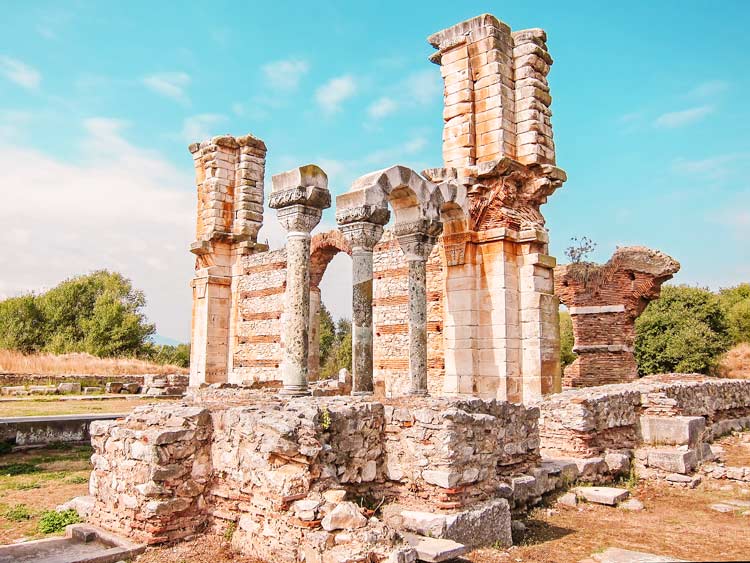
Natural Landmarks in Greece
26. SPINALONGA ISLAND, CRETE
Sitting just off the coast of Crete, Spinalonga Island was used to quarantine lepers from 1708-1953, and it has been called one of the darkest places in Greece because many people died there during this time.
What makes Spinalonga one of the most popular tourist attractions in Crete is that it offers both, beautiful views and incredible history, to visitors.
During Venetian rule in Greece, Spinalonga was completely fortified. At this time, salt was harvested from various salt pans around the island, and traded across Europe.
In the early 20th century, when it became a leper colony, the afflicted people were exiled to the island to simply count the days until their death.
Gradually, the inhabitants of the island burgeoned into a strong community. After the the first cure for leprosy was found, the number of cases in the island started to drop.
The easiest way to reach the island is to take a 10-minute ferry from the port town of Plaka (costs about 10 euros). You can also take a boat from Agios Nikolaos or Heraklion, Crete’s capital.
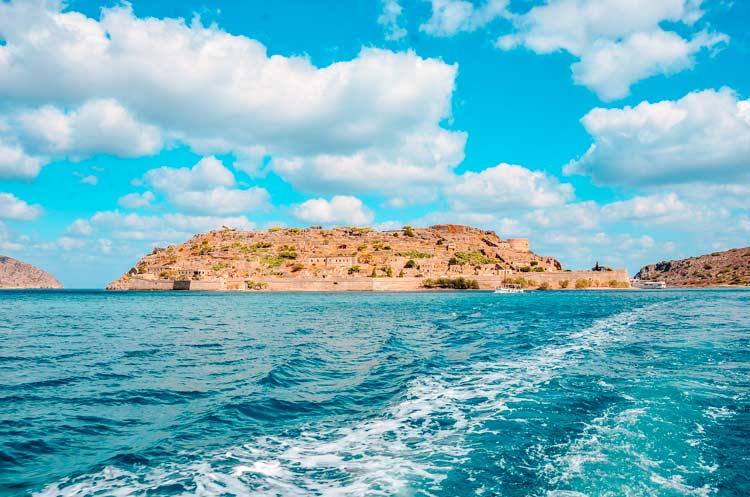
27. MOUNT OLYMPUS
Mount Olympus is a popular landmark in Greece because it is the highest mountain in the country. Its highest peak, Mytikas, is at an elevation of 2917 meters above sea level.
Not only is Mount Olympus the highest point in Greece, it has a mythological history. In ancient Greek mythology, Mount Olympus was believed to be the home of the twelve most important gods and goddesses (Zeus, Hera, Poseidon etc.).
The mountain is still considered an important landmark by many Greeks today because of its role in their history and culture.
Several hiking trails and ski tracks take you around and to the top of Mount Olympus.
If hiking or climbing mountains isn’t your thing, it’s possible to enjoy gorgeous views of Mount Olympus from nearby towns such as Litochoro and Katerini (which are popular day trip destinations from Thessaloniki and Larissa).
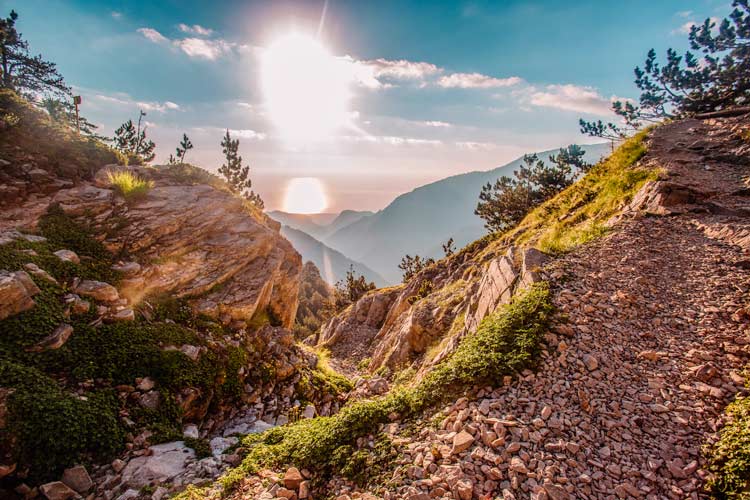
28. DELOS, CYCLADES ARCHIPELAGO
Delos is an island in the Cyclades Archipelago, close to Mykonos. It’s a significant Greek landmark as it served as one of the key religious centers in ancient Greece.
It is also a UNESCO World Heritage Site and an archaeological site that contains over 800 monuments from its heyday as a powerful trading hub during 300 BC to 100 AD. These include the Temple of the Delians, dedicated to Apollo and one of Greece’s best preserved Doric temples.
Another important landmark is the Sacred Lake, a distinct topographical feature of the area.
The island of Delos is situated within an easy day trip from Athens and Mykonos, and is absolutely worth visiting!
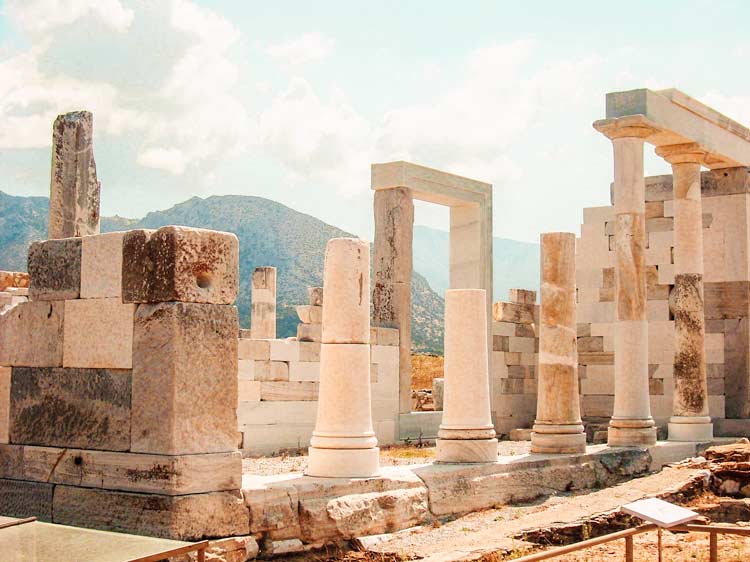
29. SARAKINIKO BEACH, MILOS
One of the many natural landmarks in Greece is the Sarakiniko Beach, characterized by its grey-white volcanic rock formations.
Often compared to a broken eggshell due to its uniquely patterned surface , this beach has been featured on postcards and calendars for years . It’s located on Milos Island – one of the Cyclades islands.
Sarakiniko is very unique and is definitely not like any other beach you’ve seen.
Best part: it’s touristy but far less compared to Mykonos and Santorini.
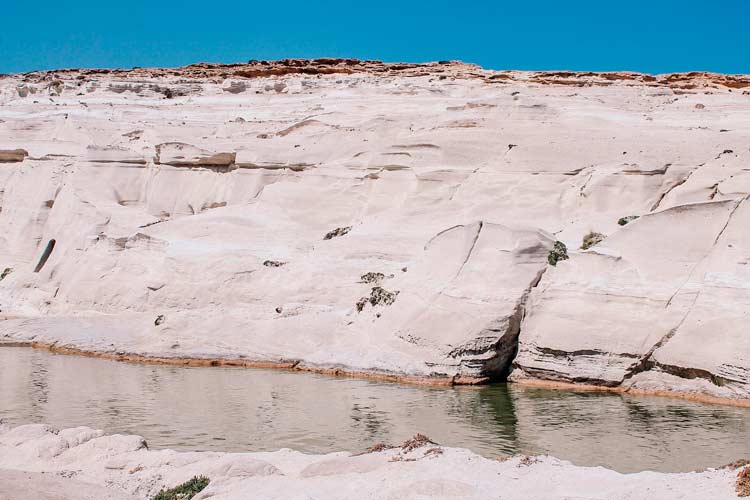
30. CALDERA OF SANTORINI
Santorini is known for its pristine beaches and blue-domed churches, but an interesting landmark that is vital to the island as we now know it, is the Caldera (literally meaning a cauldron-like depression).
A volcanic eruption took place between 1630 and 1600 BC, and the crescent-shaped bay was formed, which now sits along the coastline of Santorini.
The Caldera is essentially what remains from the said volcanic eruption, and today plays host to much of the island’s tourism industry, due to its unique geological make up.
One of the most interesting aspects about this landmark is that it’s still active, and if another eruption were to occur, scientists predict that the island would be completely submerged.

31. IONIAN ISLANDS
The Ionian Islands are a group of islands in Greece, on the western edge of the country. They stretch between Italy and Corfu.
The most famous island is Corfu, but others in the chain include Paxos, Zakynthos, Kefalonia and more.
Each island has its own unique character that makes it stand out as a destination. Some offer world class resorts while others are perfect for hiking and exploring nature.
While the islands are major tourist-pullers, they also date back to ancient Venetian rule. The Ionian Islands are, hence, an important part of Greece’s history and culture, making them one of its most famous landmarks.
Fun Fact: The islands were also the setting of Shakespeare’s play, The Tempest!
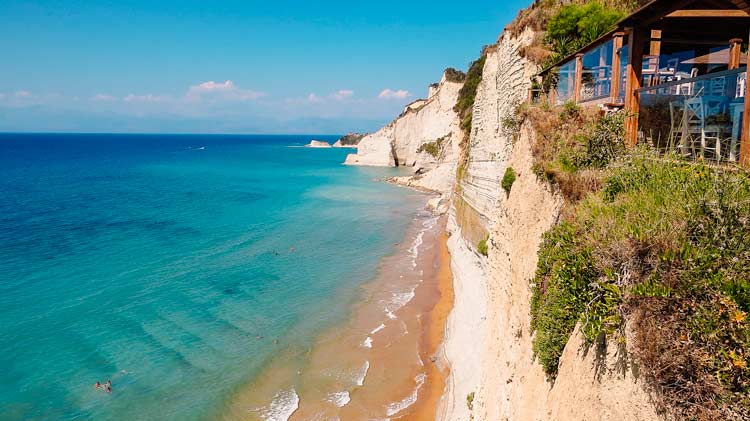
32. BLUE CAVES, ZAKYNTHOS
One of the prettiest sites in Greece, Blue Caves are a series of caves containing beautiful azure water and attracting thousands of visitors each year.
The caves have burgeoning blue-green algae, which lends the water its intense blue color. This color is so bright, it almost looks like a water painting!
You can reach the Blue Caves by taking the boat from Agios Nikolaos, or from Porto Vromi.
Another way to get to the Blue Caves (more adventurous but worth it!) is to drive to Skinari Cape, and then hike down into the water.
Blue Caves are one of the most beautiful beaches in Greece, and definitely worth a visit!
The caves are located on the coast of Zakynthos. The island itself has a very interesting history and features in the famous poems of the Iliad and the Odyssey by Homer.
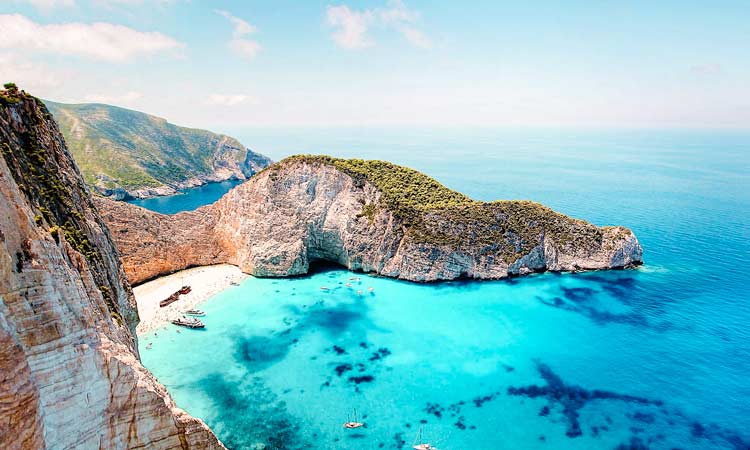
More Landmarks in Greece
33. CORINTH CANAL, CORINTH
The Corinth Canal is a short canal that connects the Gulf of Corinth with the Saronic Gulf. It cuts through the narrow Isthmus of Corinth and separates mainland Greece from the Peloponnese.
The reason why the Corinth Canal is on this list of important Greek landmarks is because many notable people tried to build it but failed, including Nero, Caligula, and Julius Caesar.
The modern Corinth Canal opened in 1893 after being built for a period of ten years by a French company.
Today, the canal remains a major tourist landmark in Greece, but it is limited to cruise ships due to its small width of just 70 feet.
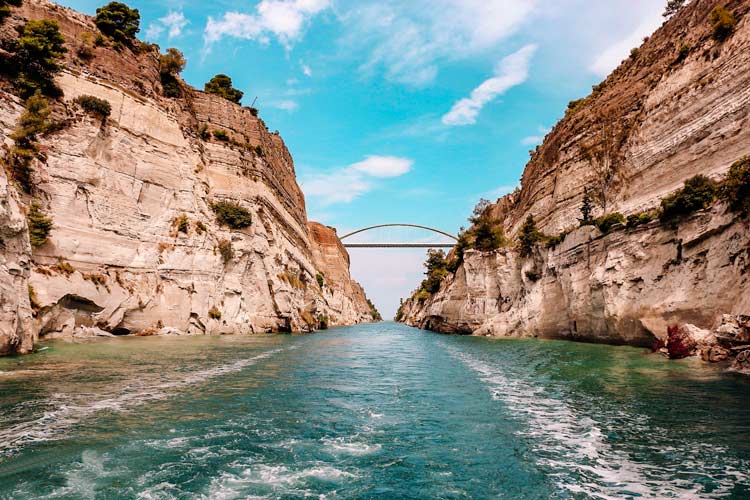
34. DOMES OF SANTORINI, SANTORINI
Every time you look up Santorini, the distinct azure domes topping pristine white buildings are the first set of images that pop up.
The iconic blue domes of Santorini are actually the rooftops of two churches, Agios Spiridonas (Saint Spyridon) and Anasteseos (the Church of the Resurrection).
The beautiful mix of blue and white made up the traditional color scheme for most Greek buildings in the past, so as to maintain parity in how the island looked.
The domes are located at the edge of the cliffs of Santorini, so you can see the entire island from above.
Downtown Santorini offers an alternative view though, with the domes watching over you. It’s pretty magical! 🙂
35. MYKONOS WINDMILLS, MYKONOS
The white windmills on the hills of Mykonos are a well-known landmark in Greece. They’re unique to this island and make for beautiful, picturesque views.
The windmills are a reminder of the island’s traditional agricultural lifestyle and have been around since the 1600s. In fact, Mykonos was one of Greece’s most important trading ports in this period. The windmills were essential for milling wheat from the surrounding farmland into flour.
By the 1800s, the commercial use of the windmills declined, and by the 20th century, they were converted completely into a tourist attraction.
Fun Fact: The windmills are visible from every part of the town of Mykonos, the island’s capital (also called ‘Chora’).
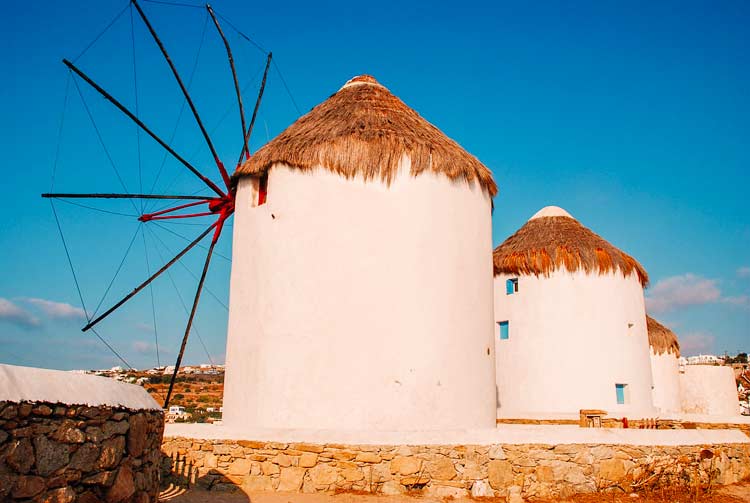
36. CHURCH OF HAGIA SOPHIA, THESSALONIKI
The Cathedral Church of Agia Sophia of Thessalonica, or the Church of Hagia Sophia, is located in the Greek city of Thessaloniki.
The namesake of the monument in Istanbul, the church is located in the center of the old town.
The building reputedly stands on the site of a pre-Christian temple. It ranks, in fact, as one of the oldest extant church buildings in the world.
A basilica dedicated to Saint Demetrius was erected here by Thessaloniki’s Roman imperial patrons. This was destroyed, most likely by an earthquake. Subsequently, the present-day structure was erected in the 7th century, modelled on the Hagia Sophia mosque in Constantinople (present-day Istanbul).
The building went through several cycles of restoration and destruction.
Because of its history, the building is a great example of Greece’s Byzantine architecture.
The Church of Hagia Sophia in Thessaloniki was recognized as a UNESCO World Heritage Site in 1988.
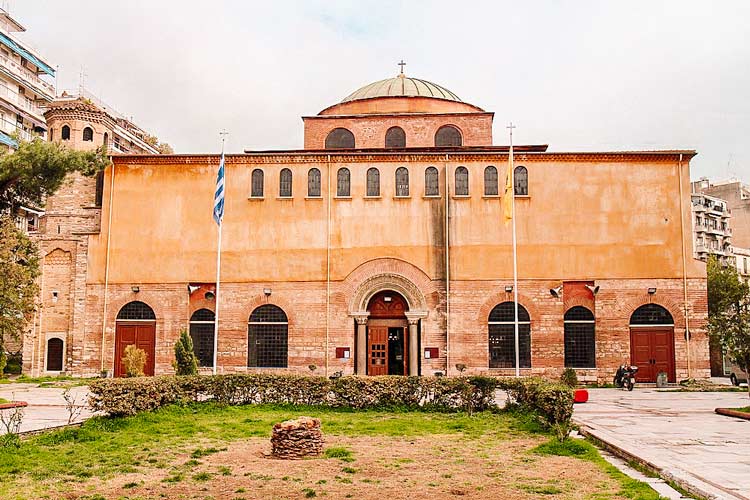
[You Might Like: 15 Europe Travel Tips to Save You Money]
37. MOUNT ATHOS MONASTERIES, KARYESA
The Mount Athos Monasteries are a prime example of the position of the Orthodox Church and its history in Greece.
The Monastic Republic is home to 20 Eastern Orthodox monasteries, and this area has been named a World Heritage Site since 1988.
These Monasteries are located on the peninsula of Mount Athos (also called Eastern Orthodox Sinai), and together they constitute one of the most important centers for early Christian indoctrination.
At present, only men are allowed to visit the territory of Mount Athos, which is called the “Garden of Virgin Mary” by the monks. Access is only possible through special limited period passes.
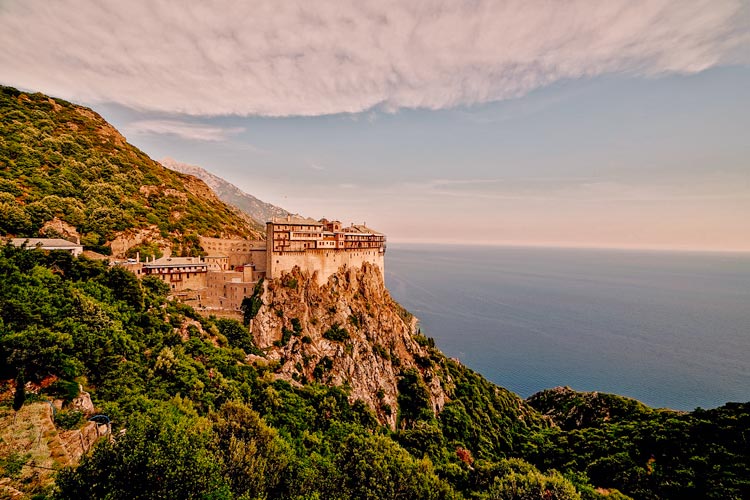
38. SHIPWRECK ON NAVAGIO BEACH, ZAKYNTHOS
The Shipwreck on Navagio Beach is one of the most photographed landmarks in Greece.
Also known as Shipwreck Bay, it is located on the Ionian Island of Zakynthos.
The spot gets its name from a tragic event where a ship ran aground, due to stormy weather, while smuggling contraband cigarettes into Italy during the 1980s. Since then, the abandoned shipwreck has become part of the island’s landscape.
To get to Navagio Beach, you can catch a boat from multiple locations like Porto Vromi Maries, Agios Nikolaos, Zakynthos Town and Skinari.
There is also a small protected observation platform, from where you can get gorgeous panoramic views of the bay. Although it is important to be careful and not risk walking up to the very edge of the cliff- you might/might not get the perfect selfie but if you fall off, there will be no aid available. The risk is your own.

FINAL THOUGHTS
As you can see, Greece is home to some of the most popular landmarks in Europe and the world. While this list isn’t exhaustive, it gives you a solid overview of the most important and famous Greek landmarks you should know about.
You can experience everything from ancient ruins and museums to beautiful beaches and islands.
I hope even you’re now as fascinated by the rich history of this beautiful country as I am. If you’re planning a trip to Greece, be sure not to miss these popular attractions!
You Might Also Like:







